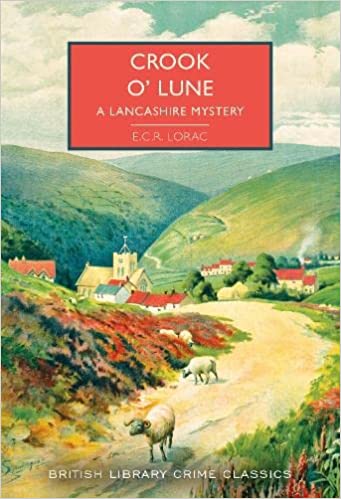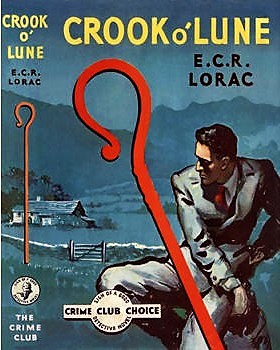Crook O’ Lune is the latest E. C. R. Lorac mystery to be reprinted by the British Library, her regional settings being a particular draw for readers. Rural Lancashire is a locale Lorac knew well, living in the area for many years to be closer to her sister. Martin Edwards, in his introduction to the new edition, goes into more detail regarding the fact and fiction of the novel’s setting, as well the personal research he did in the area.
Forewords don’t always particularly grab me, but I found Lorac’s entertaining, in the way it is directed towards those from America, New Zealand and Australia:
‘No character in this book is real – except perhaps the Hoggetts*, and they bear me no ill-will for having turned even their cows into fiction. And to those of you overseas who think you might be descended from bygone Teggs and Fells and Shearlings and Lambs, well, the folk in the valley are a fine race, so good luck to all of you. Incidentally, the house I have called Aikengill is not for sale, nor is it to let, I live in it myself.’
*The Hoggetts were based on her sister and her brother-in-law.
Synopsis
‘It all began with sheep-stealing. A hateful act among the shepherds of the fells, and yet not a matter of life and death. Then came arson and with the leaping of the flames, death and disorder reached the peaceful moors. Holidaying with his friends the Hoggetts in High Gimmerdale while on a trip to find some farmland for his retirement, Robert Macdonald agrees to help in investigating the identity of the sheep-stealers, before being dragged into a case requiring his full experience as Chief Inspector of Scotland Yard.’
Overall Thoughts
Published as Shepherd’s Crook in the USA, the story commences with Gilbert Woolfall, whose uncle has left him, in his will, a property called Aikengill and some surrounding land. It is from this act that the mystery springs. Woolfall has become charmed with the area and is considering keeping it on, but it is not an idea universally approved of. A local farmer wants to buy the property, it abuts his own land and it provides him with a way of setting up other family members. Then there is the vicar who thinks he ought to have received a bequest in the will and who may know some people interested in buying the place. But do these intentions become motive for arson and death? It is interesting to see how both these men think they have a right or claim to Woolfall’s property or inheritance and simultaneously do not see how he might have one for remaining in the area.
A historical stipend to the church from the 17th century adds a further dimension to the situation and the way it was transferred outside of the area in the early 1900s. For social historians Lorac’s novel offers a window on the way the Church of England was evolving to support itself and cope with the changing population numbers in rural areas.
In keeping with the countryside setting, the initial crime problem in the area is sheep rustling, an offence influenced by poor meat rations which have encouraged a black market for it. I felt this was a fitting, yet unusual element, as it is not one you always come across in vintage crime fiction, although I am aware of an example of cattle maiming in a short story by Baroness Orczy entitled ‘A Christmas Tragedy’.
Chapter 4 sees the arrival of Chief Inspector Macdonald who is on holiday, looking for a farm to buy, thinking ahead to his future retirement. Yet it naturally becomes a busman’s holiday when he learns that Woolfall’s house has been set on fire, part of it having been gutted before the fire could be put out. Unfortunately, this is not a case of arson without casualties as someone who was not expected to be there, was, and consequently died due to smoke inhalation. Were they collateral damage, an accidental victim? Or were they the target? The motive for the crime is initially unclear. Where’s the profit? Was it out of spite or malice? A popular theory held by locals and police alike is that sheep rustlers had set off the fire as a distraction, yet I have to admit its very popularity made me suspicious of it. It’s a trope in its own right really, that the first theory latched on to is not likely to be the right one. I wonder if such a trope is used to provide a contrast when there is more than one line of investigation being run by different detectives. Nevertheless, the choice of victim surprised me.
There is a high amount of description and nature writing is a consistent thread throughout the novel, but especially in the first third. I am not overly keen on large amounts of description, as I find a little goes a long way, but I still enjoyed the story characters wise. One consequence of this is that the plot is not a quick moving one. However, the setting did feel familiar in a way, as the landscape did not sound altogether too different to parts of Northumberland and it also reminded me of my grandparents’ farm.
A considerable part of the investigation concerns a young tramp and whether he was involved in the crime or a witness to it. Yet I think this was used more as a vehicle for describing the rural landscape at night, than as a way of developing the mystery. It takes up a large space in the book but does not contribute much to the final solution. An issue with this mystery is that there are no serious red herrings to distract the reader from noticing the only likely source of motive/solution. The case is too sparse and there are not enough new developments to compensate for this. Therefore, the killer was not a surprise to me, although I am not sure how the reader is able to work out all the details of the motive, as Macdonald sets off some research activities, but his findings are not revealed until the solution. It felt too off the page for me. So all in all I don’t think this is the best plot by Lorac that I have read, but I think there is much to enjoy in terms of the setting and character.
Rating: 3.5/5 (Plot and Mystery aspect) 4/5 (Characters and setting)
Source: Review Copy (British Library Crime Classics)


I read it a while back and am still unclear who was responsible for the sheep rustling. Enjoyable read though and the amusing surnames were a great bonus, even if the puns did go way over most readers’ heads!
LikeLiked by 1 person
It is the same culprit for both crimes.
LikeLike
I too found the intro almost as interesting as the novel itself and with so much info couldn’t resist some Googling to learn more . I then used the Ordinance Survey app to get a full picture in my mind of the topography that helped with reading the book. As an aside whilst Googling I came across her house on AirB&B and it seems you can now rent the end of the house where the author positioned her fire . What fun I thought to sit there on a rainy day and read the book. Surprisingly the owners make no mention of the book on their site. Clearly not GAD fans !
LikeLiked by 1 person
Sounds like they are missing a trick not including that info on the Air BnB website, sure there would be many who would want to stay for that very reason.
LikeLike
I’m about to start this book and also will be consulting a map. Being an American who hasn’t traveled much in the UK, I’m completely unfamiliar with Lancashire. I do enjoy Lorac’s detail about her countryside settings.
LikeLiked by 1 person
[…] Crook o’ Lune (1953) by E. C. R. Lorac […]
LikeLike
[…] where she herself went to live. I have read some of the other books she set there, such as Crook O’ Lune (1953), but Fell Murder is Chief Inspector Macdonald’s first murder investigation in the […]
LikeLike
[…] Crook O’ Lune by E. C. R. Lorac […]
LikeLike
I really enjoy Lorac’s books, with one or two exceptionas. I found it mildly irritating that the characters have names associated with sheep or the landscape, which made it like a children’s book where the people are given the name of the job they do. She clearly had a dim view of non farming people. As a mere townie I spotted the following, though there may be more: Shearling, Lambsrigg, Hoggett, Woolfall, Gimmer, Ramsden, Fell, Herdwick, Tupper and Tegg
LikeLiked by 1 person
There were a lot of sheep related surnames, however I wonder if this reflects the area she eventually lived in. A sheep farming community which had been so for centuries may well have generated a lot of a sheep based surnames.
LikeLike
[…] Berkeley, The Ninth Enemy (1948) by Francis Vivian, Villainy at Vespers (1949) by Joan Cockin, Crook O’ Lune (1953) by E. C. R. Lorac, Our Jubilee is Death (1959) by Leo Bruce and Lament for Leo (1971) by […]
LikeLike
[…] of the Lake District. The titles are as follows: Fell Murder (1944), which is set in Lancashire, Crook O’Lune (1953), The Theft of the Iron Dogs (1946) and Still Waters (1949) – the latter of which I […]
LikeLike
[…] attempt to differentiate the book from Lorac’s mysteries such as The Theft of the Iron Dogs and Crook O’Lune, and to reinforce the fiction that Carol Carnac and E. C. R. Lorac were two different […]
LikeLike